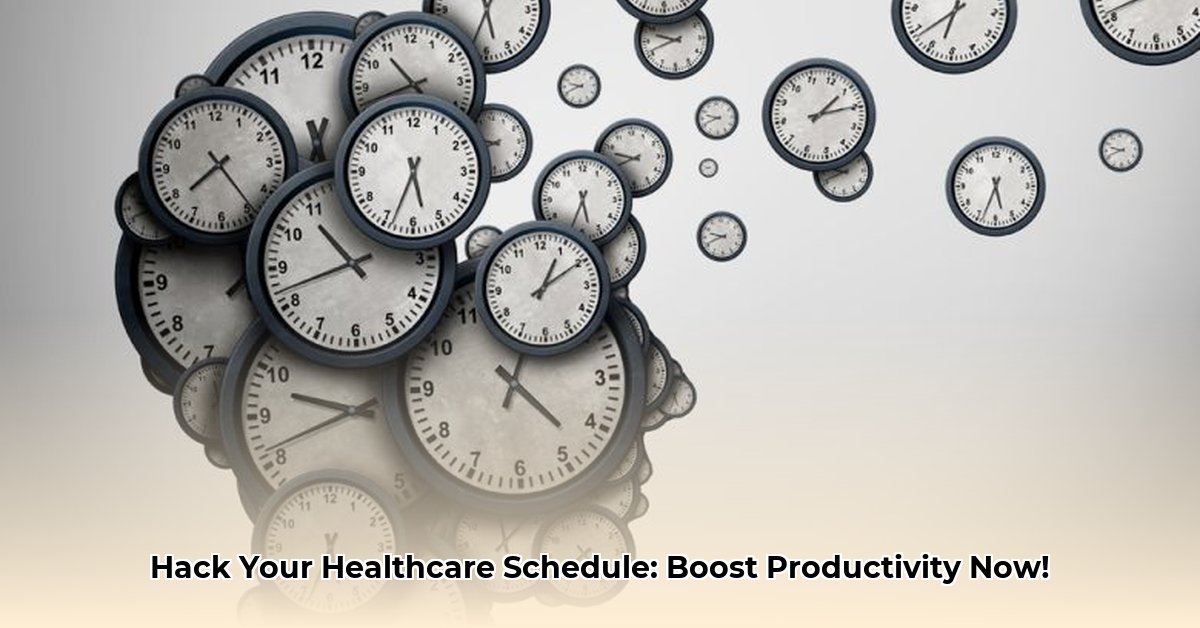Feeling overwhelmed by your demanding healthcare job? Juggling patient care, administrative tasks, and personal life can seem impossible. This guide offers practical strategies to regain control of your time, boost productivity, and improve overall well-being within the healthcare setting. For more on nursing time management, check out this helpful resource: Nursing Time Management.
Prioritization Techniques for Healthcare Professionals
Effective prioritization is essential for managing time effectively. Let’s explore how to make the most of your time.
The Eisenhower Matrix: A Tool for Efficient Task Management
The Eisenhower Matrix, also known as the Urgent-Important Matrix, categorizes tasks based on their urgency and importance. Urgent and important tasks require immediate attention, while important but not urgent tasks can be scheduled for later. Delegate urgent but unimportant tasks if possible, and eliminate tasks that are neither urgent nor important. This simple yet effective method helps you prioritize effectively. How can you apply this matrix to your daily tasks?
Consider this example: A patient experiencing severe chest pain requires immediate attention (urgent and important). Reviewing updated clinical guidelines can be scheduled for later (important but not urgent). Responding to non-critical emails can be delegated to an administrative assistant (urgent but not important). Browsing social media during work hours should be eliminated (neither urgent nor important). Regularly applying the Eisenhower Matrix can dramatically streamline your daily workflow.
Technology to Enhance Time Management Skills
Leverage technology to enhance your efficiency. Modern healthcare relies heavily on technology, and you should too! Electronic Health Records (EHRs), scheduling software, and secure communication platforms can significantly improve efficiency by automating administrative tasks, eliminating manual data entry, and simplifying appointment scheduling. To what extent can these tools streamline your daily tasks?
For example, EHRs allow quick access to patient histories, reducing time spent searching for paper records. Scheduling software automates appointment reminders, decreasing no-shows. Secure messaging apps facilitate quick communication with colleagues, avoiding phone calls. These technologies not only save time but also minimize errors and improve coordination.
Delegation for Enhancing Productivity and Team Collaboration
Delegation is not just about offloading work; it’s about empowering your team members and developing their skills. Identify tasks which can be handled by others, provide clear instructions and expectations, and offer training and support as needed. Effective delegation frees you to focus on tasks that require your expertise and judgment, improving team collaboration and reducing individual burdens. How can you use delegation to free up your time for crucial tasks?
Consider delegating tasks such as routine patient vitals, medication refills (under physician orders), and basic administrative tasks to qualified medical assistants or nurses. This frees up physicians and senior nurses to focus on more complex patient care, diagnoses, and treatment planning.
Protect Your Time and Well-being
Protecting Personal time and well-being is very important. Establish clear boundaries regarding work communication outside of regular hours and schedule dedicated time for personal activities to maintain a healthy work-life balance. A well-rested, less-stressed healthcare professional is a better caregiver. How would setting boundaries improve your work-life balance?
For example, you could set a rule to not check work emails after 7 PM or during weekends, unless on call. Dedicate specific time slots for exercise, hobbies, and family time. Clearly communicate your availability to colleagues and patients to manage expectations. These boundaries ensure you recharge and avoid burnout, ultimately enhancing your performance during work hours.
Continual Refinement for Optimal Time Utilization
Time management is an ongoing journey. Regularly review methods, identify areas for improvement, and adapt strategies to match evolving role demands. How might tracking your time reveal areas for improvement?
Use time-tracking apps or simply keep a log of how you spend your time each day. Analyze this data to identify time-wasting activities, bottlenecks in your workflow, and areas where technology or delegation could further improve efficiency. For instance, you might discover that you spend an excessive amount of time on phone calls, which could be reduced by using secure messaging platforms or implementing a call-back system.
Concrete Ways to Master Time
Here are some actionable steps to improve time management:
- Batch similar tasks: Grouping similar tasks minimizes context switching and improves efficiency.
- Employ time blocking: Allocating specific blocks of time to specific tasks enhances structure and focus.
- Minimize distractions: Eliminating distractions fosters focus and concentration.
- Schedule short, regular breaks: Taking short breaks prevents burnout and improves concentration.
- Plan your day: Creating a clear plan helps prioritize tasks and stay organized.
- Review and adjust: Daily reflection enables continuous improvement.
Risk Mitigation for Time Management Tools
Consider these strategies when implementing new time management tools:
| Tool | Potential Risks | Mitigation Strategies |
|---|---|---|
| EHR Systems | Data breaches, system downtime, software glitches | Robust security protocols, regular backups, disaster recovery plans, user training, IT support |
| Scheduling Software | Overbooking, integration challenges, user error | Thorough testing, user training, clear guidelines, regular updates |
| Communication Platforms | Miscommunication, privacy concerns, security breaches | Secure platforms, clear communication protocols, strong passwords, data encryption |
| Time Management Apps | User error, lack of integration, data privacy concerns | User training, selection of compatible and reputable software, review privacy policies |
Remember that consistent implementation leads to increased productivity, reduced stress, and more time for providing excellent patient care and maintaining a healthy work-life balance.
Effective Delegation Strategies in Healthcare
Feeling overwhelmed? Delegation is a secret weapon for reclaiming your time and improving patient care.
- Delegation frees up time for higher-priority tasks.
- Effective delegation improves team collaboration and skill development.
- Successful delegation requires clear communication and trust.
- A structured approach minimizes errors and ensures accountability.
The Delegation Process
Effective delegation involves strategically assigning responsibilities, empowering team members. What can you do to ensure tasks are assigned to the right people?
Consider the skills, experience, and workload of each team member. Match tasks to individuals who have the necessary competencies and available time. Provide training and support to ensure they can successfully complete the delegated tasks. Recognize and reward successful delegation to foster a culture of teamwork and shared responsibility.
A Step-by-Step Guide to Seamless Delegation
Follow these steps for seamless delegation:
- Identify tasks: Prioritize based on urgency and importance.
- Choose the right person: Delegate to individuals with necessary skills.
- Provide clear instructions: Set clear expectations and deadlines.
- Grant authority: Empower decision-making and provide resources.
- Establish communication channels: Ensure regular updates and feedback.
- Monitor progress: Offer guidance without micromanaging.
- Provide feedback: Offer constructive criticism and acknowledge achievements.
Removing The Roadblocks
Even with a plan, challenges arise. Building trust and open communication alleviates concerns about relinquishing control, quality, and lack of trust. How can you build that trust to empower your team?
Establish open communication channels where team members feel comfortable asking questions and providing updates. Clearly define roles and responsibilities to avoid confusion and overlap. Offer constructive feedback and acknowledge accomplishments to build confidence and foster a sense of ownership. Lead by example, demonstrating trust in your team’s abilities.
Refine Your Delegation Approach
Consider these additional factors to refine your delegation approach:
- Develop a Decision Delegation Ladder: Establish a clear hierarchy for decision-making.
- Implement a Meeting Reset Protocol: Optimize efficiency to reduce wasted time.
- Adopt an Energy Management Framework: Prioritize tasks based on energy levels.
Consider implementing a decision delegation ladder, where different levels of decision-making authority are clearly defined. For example, routine patient care decisions might be delegated to experienced nurses, while more complex treatment plans require physician approval. This clarifies who has the authority to make which decisions, streamlining the delegation process.
Optimizing Healthcare Workflows through Time Management
Let’s explore the integration of key time management strategies to enhance overall healthcare workflows.
- Prioritize tasks effectively using methods like the Eisenhower Matrix.
- Implement time-blocking techniques for focused work periods.
- Delegate non-essential tasks to free up your time.
- Leverage technology (EHRs, scheduling software) to automate tasks.
- Plan for unexpected events and build flexibility into your schedule.
- Address organizational barriers to implementing new strategies.
- Continuously monitor and refine your time management approaches.
The Eisenhower Matrix for Strategic Task Management
Use the Eisenhower Matrix strategic task management to categorize and prioritize tasks for strategic decision-making. How can this matrix transform your daily operations?
It allows healthcare professionals to differentiate between pressing patient needs (urgent and important), long-term planning (important but not urgent), tasks that can be delegated (urgent but not important), and activities that should be eliminated (neither urgent nor important). This focused approach ensures resources are allocated to critical areas, enhancing overall operational efficiency.
Time Blocking to Create Efficient Schedules
Time-blocking involves scheduling specific blocks of time for particular tasks. Creating a roadmap minimizes context switching, boosting concentration and productivity. How can you build a solid schedule with the blocks of time?
Allocate specific time slots for patient consultations, administrative tasks, meetings, and breaks. For example, schedule 9:00 AM to 11:00 AM for patient appointments, 11:00 AM to 12:00 PM for charting and documentation, and 12:00 PM to
- Doctor Work Life Balance: Proven Strategies for Physician Well-being - November 20, 2025
- Find Your Work-Life Harmony: Quotes for a Fulfilling Life - November 18, 2025
- CRNA Work-Life Balance: Strategies for a Healthier Lifestyle - November 16, 2025
















